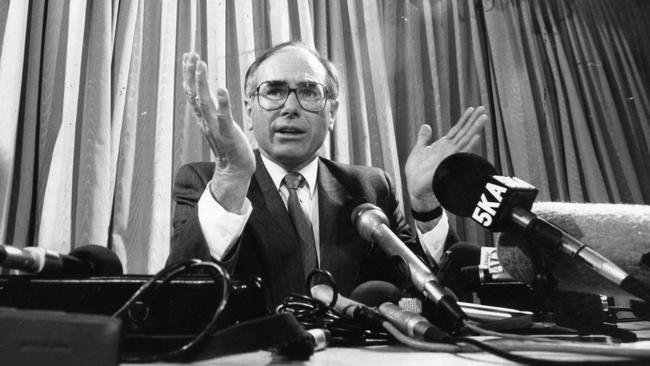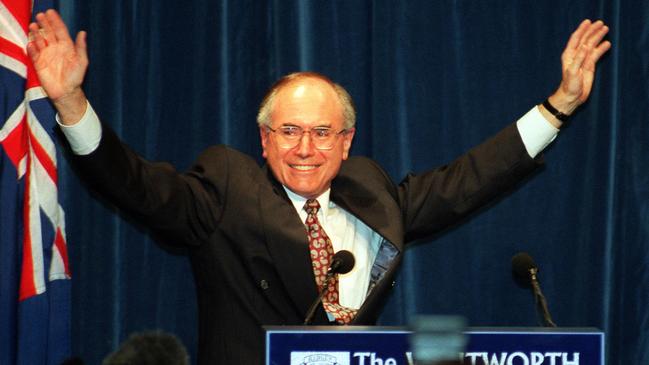John Howard: a study in resilience
When Bob Hawke led John Howard as preferred PM by a whopping 69-18 per cent margin, The Bulletin famously asked: ‘Mr 18% – Why on earth does this man bother?’

In his final year at Canterbury Boys High School in 1956, John Howard nominated journalism as one of three occupations he would consider pursuing after completing his studies. (The others were a lawyer or detective.) On June 2, 1989, just weeks after being toppled as Liberal Party leader, Howard began a regular column for The Australian.
The formal offer came from editor Frank Devine in a letter on May 19. They had finalised the terms the day before. Howard would write a 1200-word column on Fridays with a focus on “national affairs”. He would be paid $800 a column. Not bad for an opposition backbench MP. But Devine made it clear Howard had to deliver for readers. “This is a pretty exciting undertaking, I think,” Devine wrote to Howard. “Winston Churchill and Jack Kennedy (and Eleanor Roosevelt!) come to mind especially as persons of affairs who were genuinely distinguished as journalists.” Devine told him “the best political columnist in the world” was Bill Safire, formerly Richard Nixon’s speechwriter, who wrote for The New York Times.
The five months of columns between June and November 1989 explored a variety of topics from industrial relations and economic policy to welfare reform and the environment, to events in Asia and Europe, forays into memoir reflecting on his battles with Queensland premier Joh Bjelke-Petersen and Allan Border’s captaincy of the Australian cricket team when the Ashes were reclaimed.
These columns have now been collated into a fascinating book, John Howard: From the Pavilion, edited by Andrew Blyth. The cricketing metaphor would appeal to the cricket tragic Howard, who was then watching and commentating on politics from afar and no longer as a leading member of the Liberal team out on the field. Howard was in political exile.
Howard recalls that he “jumped at the offer” to moonlight as a political commentator. He had, after all, once dreamed of being a journalist. “So began a very pleasurable experience of penning a regular column for the national newspaper,” he writes in an afterword. “I enjoyed the experience immensely and found writing on any manner of subjects anything but a chore.”
How Howard became “something of a part-time journalist”, as he describes it, needs retelling. Andrew Peacock, who had surrendered the Liberal leadership to Howard four years earlier on September 5, 1985, had launched a surprise comeback challenge. It was orchestrated by a group whose members labelled themselves “cardinals” and they later boasted about their underhanded tactics on the ABC’s Four Corners program. Peacock returned as leader, defeating Howard, 44 votes to 27, in a partyroom ballot on May 9, 1989.

Howard’s leadership had been on death watch. When the Morgan Gallup poll showed Bob Hawke leading Howard as preferred prime minister by a whopping 69-18 per cent margin, The Bulletin famously asked in a cover story on December 20, 1988: “Mr 18% – Why on earth does this man bother?” It was brutal. Voters overwhelmingly favoured Peacock’s return to the Liberal leadership.
Although many journalists declared Howard finished in politics, he was not done yet. He used the time to reflect on policy, rebuild relations with colleagues and sharpen his communications skills. The column enabled him to showcase his intellect. He would bide his time and keep his options open. If the Liberal Party returned to power, he would be a minister. But Howard was aiming higher.
From the Pavilion is an intriguing time-tunnel into the past. It allows the reader to see Howard at a moment in time that would be important in his political revival, although it would take many years. His choice of topics, as ever for the columnist, had to be interesting and relevant, and the writing had to be clear and incisive. Howard – as he would later demonstrate as an author – had a flair for writing.
Howard would file his columns on Thursday morning via facsimile but could make changes until 6pm that evening. Devine kept a close eye on his recruit to the opinion pages and served as his editor for the first month or so. Howard recalls Devine offered occasional counsel in the first few weeks and encouraged him to “always strive to simplify” his arguments.
Devine, writing “as one journalist to another”, wisely suggested four tips for writing columns. First, focus on a single subject or theme. Second, fill each column with facts and use anecdotes. Third, let Howard be Howard. Devine said the “quirks and enthusiasms” of the writer are “very much the stuff of serious popular journalism”. And fourth, do not try to emulate other columnists.
Few serving politicians are afforded the opportunity to write columns. It can be a tricky enterprise because they must remain interesting and insightful for readers but, if they are eyeing a political future, be careful not to undermine the leadership of their party with overly critical commentary. It is a balancing act.
“Although I was no longer a member of the Coalition frontbench and had the freedom to write as I chose, I remained committed to the return of a Liberal-National Party government,” Howard recalls. “Nonetheless on occasions, such as during the pilots’ strike, I argued for an outcome consistent with the long-held views I had expressed on industrial relations. The official Coalition position was a little different. I also expressed strong opinions on Queensland politics, conditioned by my bruising experience during the chaotic ‘Joh for PM’ years.”
It is remarkable to look back at several of Howard’s columns and see how his views have remained consistent on a range of public policy issues, whether it is making the case for welfare reform or labour market deregulation, further privatisation of public assets, changes needed on the waterfront, reducing red tape and easing the taxation burden.
The columns also canvassed global issues such as the student-led protests in Beijing, the changes in the Soviet Union and apartheid in South Africa. These matters were challenging to analyse. Howard argued against sanctions on South Africa. Yet that campaign, in which Hawke was a leader, is widely accepted to have hastened the demise of apartheid.
His love of cricket is given full expression in a column that celebrated the Ashes win in August 1989. Headlined “A sportsman bordering on true greatness”, Howard notes that Border showed a “combination of courage and modesty” in captaining the team to victory. In describing Border’s character as defined by grit, resilience and determination, readers may have thought it could be autobiographical.

Many of Howard’s columns in The Australian reflected the conservative values espoused in his December 1988 policy manifesto, Future Directions. That 109-page document did little to elevate the opposition’s fortunes at the time, but it did articulate a strong Howard belief in individual liberty, private enterprise and support for families, which remained political touchstones.
Revisiting the columns he wrote more than 30 years ago has been rewarding for Howard. “There is not much I would like to take back,” he writes. “That is a source of some satisfaction because what I wrote more than three decades ago was consistent with the broad-church Liberalism I have long espoused.
“Values such as individual freedom, private enterprise, pride in one’s country and respect for the role of the family are timeless. They are as relevant today for the Liberal Party and Australia as they were more than 30 years ago.”
Howard’s wilderness years, as I write in an endorsement for the book, are a study in resilience, determination and ambition. By November 1989, Howard had returned to the opposition frontbench. The agreement with Devine was terminated. The columnist had returned to frontline political duties and the column ended. But the road back to the Liberal leadership would take five more years.
Although the Liberal Party thought Peacock would be more likely to lead it to victory on March 24, 1990, it was not to be, as Hawke took Labor to an unprecedented fourth election win in a row. Although Peacock had come close to victory, the party was shell-shocked, and he stood down from the leadership.
The Liberal Party turned to John Hewson, on April 3, 1990, who went on to lead it to a fifth defeat on March 13, 1993. The party stuck with Hewson after the election and then on May 23, 1994, chose Alexander Downer to lead it. Howard had been overlooked for the leadership multiple times. But on January 30, 1995, he returned to the top job unopposed. A little over a year later, he was prime minister.
It is one of the most extraordinary comebacks in Australian political history. The seeds of Howard’s comeback were, in part, sown in his stint as a columnist for The Australian. In these pages, a once and future leader articulated the ideas, values and policies that were to be the foundation of his Lazarus-like return, eventually becoming Australia’s second-longest-serving prime minister.
John Howard: From the Pavilion is edited by Andrew Blyth and published by Connor Court Publishing
-
Howard’s thoughts from the pavilion
Allan Border has reminded all of us that true sportsmanship is a combination of winning and grace. He has reminded us that we can be proud of our sporting heroes even if they don’t always ‘win one for Australia’. He has gone through the rough times, tasted defeat, faced up to the pressure and displayed great resilience. At the end of this he has won and won well and of course winning well is arguably as important as losing well.
August 11, 1989
We must surely accept that the real economic challenge is to create a more productive Australian economy which enables us to earn enough in the future to pay for a high level of consumption that is to have a high living standard. That being the case, the only feasible option for Australia is to push ahead and complete the deregulation of our economy.
July 14, 1989
One of the real achievements of Margaret Thatcher has been to turn her face against special interest groups in Britain where she believes their demands or entrenched privileges are not in the national interest. The most celebrated has been her historic breaking of the unjustified power of the trade union movement. Less publicised, but no less important, has been her willingness to tackle perceived monopoly positions of groups such as lawyers.
August 18, 1989
It is beyond doubt that the Queensland National Party has badly let down the conservative cause in recent years. The disastrous ‘Joh for PM’ campaign which did more than anything else to re-elect the Hawke Government in 1987, together with the administrative and other failures revealed by the Fitzgerald Report, should on any normal criteria disqualify the Queensland Nationals from any voice in the next Government of Queensland.
October 27, 1989
The parameters of the economic debate between the major parties has narrowed, especially in the area of budget policy. Differences remain there but they are of degree rather than amounting to sharply varying approaches. The economic battleground of the 1990s will unquestionably be not only the areas which must be subject to major economic reform, but the pace at which that reform occurs. The 1980s was the era of financial market deregulation. The 1990s must be the era of labour market deregulation.
November 3, 1989



To join the conversation, please log in. Don't have an account? Register
Join the conversation, you are commenting as Logout